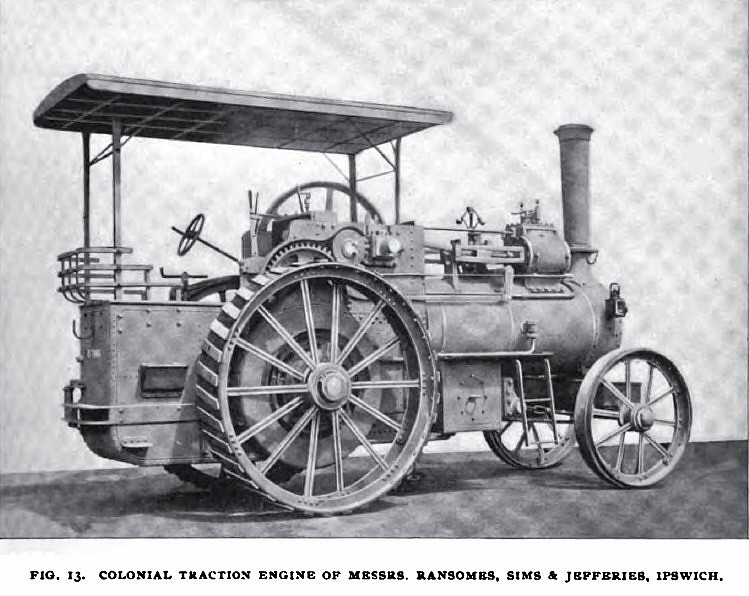|
Title: |
1896 Article-Ransomes, Sims & Jefferies, Colonial Steam Traction Engine |
|
Source: |
Cassier's Magazine Jun 1896 pg 147 |
|
Insert Date: |
7/20/2011 2:55:39 PM |
|
Fig. 13 shows a single cylinder, general purpose traction engine made by Messrs. Ransomes, Sims & Jefferies, of Ipswich. This engine is suitably equipped for use in the colonies. The greatest care has been bestowed on it, so as to render it as simple as possible. The number of details has been cut down to the utmost limit, but in no case has real efficiency been sacrificed thereby. All the latest improvements have been embodied in the design, while the workmanship is of the highest description—equal to the work produced in the best railway locomotive shops. The boiler is made entirely of steel and suitably stayed for a working pressure of 140 pounds per square inch. Before being erected the boiler is subjected to a water test pressure of 240 pounds per square inch. The plates are flanged by hydraulic pressure, and the riveting is also done by the same means. The steel shafts and main driving axle are carried in brackets, fitted into the side plates of the firebox shell, which are extended upward and backward for the purpose. These side plates are stiffened by flanged transverse plates, which are riveted in as shown. This forms a box in which the crank, the eccentrics and the first motion gearing are nicely arranged. The engine is fitted with compensating gear on the main axle, so that it can turn sharp curves without loss of tractive power. This gear relieves the axles of much strain, and, when necessary, the differential gearing can be locked, so that both wheels revolve with the axle. On the main axle the winding drum is also fixed. This drum is so made that the steel rope can be paid out as the engine travels forward,—an arrangement that effects a great saving of time. Suppose we wish to haul a heavy load up a steep hill with the drum and wire rope. Instead of taking the engine up the hill and pulling the rope out by hand, as was formerly done, it is only necessary to attach the rope to the wagon to be hauled up and run the engine to the summit of the hill, paying out the rope all the time. By pressing down a spring pin the drum is then put into gear, and the rope is wound up without a moment's loss of time. The whole of the spur gearing is made of cast-steel, so that breakages are rarely heard of, and the wear is reduced to a minimum. Two speeds are provided, — one for drawing heavy loads up hill, or over bad roads, at two miles an hour; and the other, for lighter loads on level and good roads, giving a speed of four miles an hour. The arrangement of this gearing is such that only one lever is required for changing the speed, and one pinion is thrown out before the other is put in gear. All the shafts, axles, piston and valve rods are of steel. The pins, joints and general wearing parts are made of ample dimensions for reducing the wear to the utmost, while special care is devoted to the proper case-hardening of these parts. The cylinder is steam-jacketed, so that neither air nor water can be trapped and retained in the jacket. When running on the road, the governor is not used, but when the engine is used, as it can be, for driving machinery by a belt from the flywheel, the governor is required. A second tank is fitted under the boiler barrel, carrying an extra quantity of water, and both tanks are connected by means of a pipe. A good bit of road can thus be covered by less frequent stoppages for water. A cab is provided for sheltering the driver from the sun or the rain; it also covers the box bracket and the working parts in it. A foot-plate and ladder are fitted for the use of the driver when oiling or cleaning the engine. On the front axle there is an iron box for carrying the anchors, the hauling chains, frost spikes, cotters, etc. The engine is complete in all particulars, thoroughly economical in fuel, efficient in work, handy to manage on the road and has no details likely to get out of order or give trouble. The whole work is very sound and good, and fairly represents an example of one of England's best make of traction engines. |
|
 1896 Ransomes, Sims & Jefferies, Colonial Steam Traction Engine
1896 Ransomes, Sims & Jefferies, Colonial Steam Traction Engine
|
|